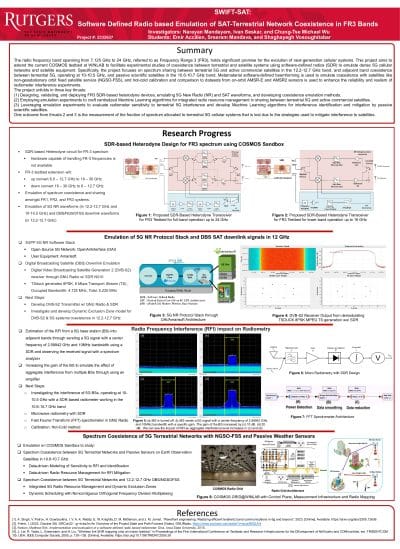Authors
Narayan Mandayam, Ivan Seskar, Chung-Tse Michael Wu, Emir Accilien, Sreeram Mandava, and Shaghayegh Vosoughitabar
Abstract
The radio frequency band spanning from 7.125 GHz to 24 GHz, referred to as Frequency Range 3 (FR3), holds significant promise for the evolution of next-generation cellular systems. This project aims to extend the current COSMOS testbed at WINLAB to facilitate experimental studies of coexistence between terrestrial and satellite systems using software-defined radios (SDR) to emulate dense 5G cellular networks and satellite equipment. Specifically, the project focuses on spectrum sharing between terrestrial 5G and active commercial satellites in the 12.2-12.7 GHz band, and adjacent band coexistence between terrestrial 5G, operating at 10-10.5 GHz, and passive scientific satellites in the 10.6-10.7 GHz band. Metamaterial software-defined beamforming is used to emulate coexistence with satellites like non-geostationary orbit fixed satellite service (NGSO-FSS), and hot-cold calibration and comparison to datasets from on-orbit AMSR-E and AMSR2 sensors is used to enhance the reliability and realism of radiometer interference experiments.
The project unfolds in three key thrusts:
(1) Designing, validating, and deploying FR3 SDR-based heterodyne devices, emulating 5G New Radio (NR) and SAT waveforms, and developing coexistence emulation methods.
(2) Employing emulation experiments to craft centralized Machine Learning algorithms for integrated radio resource management in sharing between terrestrial 5G and active commercial satellites.
(3)Leveraging emulation experiments to evaluate radiometer sensitivity to terrestrial 5G interference and develop Machine Learning algorithms for interference identification and mitigation by passive scientific satellites.
One outcome from thrusts 2 and 3 is the measurement of the fraction of spectrum allocated to terrestrial 5G cellular systems that is lost due to the strategies used to mitigate interference to satellites.

